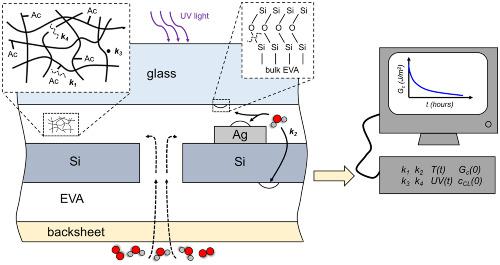当前位置:
X-MOL 学术
›
Prog. Photovoltaics
›
论文详情
Our official English website, www.x-mol.net, welcomes your
feedback! (Note: you will need to create a separate account there.)
Evaluating and predicting molecular mechanisms of adhesive degradation during field and accelerated aging of photovoltaic modules
Progress in Photovoltaics ( IF 8.0 ) Pub Date : 2018-07-13 , DOI: 10.1002/pip.3045 Jared Tracy 1, 2 , Dagmar R. D'hooge 1, 3, 4 , Nick Bosco 5 , Chris Delgado 1 , Reinhold Dauskardt 1
Progress in Photovoltaics ( IF 8.0 ) Pub Date : 2018-07-13 , DOI: 10.1002/pip.3045 Jared Tracy 1, 2 , Dagmar R. D'hooge 1, 3, 4 , Nick Bosco 5 , Chris Delgado 1 , Reinhold Dauskardt 1
Affiliation

|
Extending photovoltaic (PV) module lifetimes beyond 30 years is a goal of significant priority. A challenge that must first be addressed, however, is the development of a predictive reliability model that captures the synergy of terrestrial stressors on module degradation, particularly at encapsulant interfaces. Using a metrology designed specifically for PV modules, a comprehensive study of the widely used ethylene vinyl acetate encapsulant was performed in which encapsulant adhesion was evaluated as a function of environmental stressors (UV exposure, temperature, and humidity) for modules aged both under accelerated lab and internationally located field conditions for months to nearly 3 decades. Mechanical and chemical characterization methods are combined with fundamental polymer reaction engineering to unravel the degradation processes active at the molecular scale that lead to encapsulant delamination. An analytical and modular model framework is put forward enabling the prediction of long‐term PV module durability, starting from fundamental principles at the molecular level and explicitly accounting for bond rupture events in the bulk encapsulant and at the encapsulant interfaces. Successful parameter tuning to adhesion data indicates a dominant occurrence of deacetylation, β‐scission, and hydrolytic depolymerization, respectively. The model contributes to the longstanding challenge of predicting module lifetimes in any geographic location while minimizing time‐consuming and costly aging studies.
中文翻译:

评估和预测光伏组件在现场和加速老化过程中粘合剂降解的分子机理
将光伏(PV)模块的使用寿命延长到30年以上是一个非常重要的目标。但是,首先必须解决的挑战是开发一种预测性可靠性模型,该模型可以捕获地面应力源在模块降级(特别是在密封剂界面处)方面的协同作用。使用专门为PV组件设计的计量学,对广泛使用的乙烯乙酸乙烯酯密封剂进行了全面研究,其中评估了在加速实验室下老化的模块的密封剂附着力与环境压力(紫外线暴露,温度和湿度)的关系。和位于国际上的现场条件长达数月至近3十年。将机械和化学表征方法与基本的聚合物反应工程相结合,以揭示分子水平上有效的降解过程,从而导致密封剂分层。提出了一个分析和模块化的模型框架,该模型框架能够从分子水平的基本原理开始,并预测了大体积密封剂和密封剂界面的键断裂事件,从而可以预测光伏组件的长期耐久性。成功调整参数至附着力数据表明脱乙酰基占主导地位,从分子原理上的基本原理开始,并明确说明本体密封剂和密封剂界面中的键断裂事件。成功调整参数至附着力数据表明脱乙酰基占主导地位,从分子原理上的基本原理开始,并明确说明本体密封剂和密封剂界面中的键断裂事件。成功调整参数至附着力数据表明脱乙酰基占主导地位,β断裂和水解解聚。该模型对预测在任何地理位置的模块寿命,同时最小化耗时和昂贵的老化研究的长期挑战做出了贡献。
更新日期:2018-07-13
中文翻译:

评估和预测光伏组件在现场和加速老化过程中粘合剂降解的分子机理
将光伏(PV)模块的使用寿命延长到30年以上是一个非常重要的目标。但是,首先必须解决的挑战是开发一种预测性可靠性模型,该模型可以捕获地面应力源在模块降级(特别是在密封剂界面处)方面的协同作用。使用专门为PV组件设计的计量学,对广泛使用的乙烯乙酸乙烯酯密封剂进行了全面研究,其中评估了在加速实验室下老化的模块的密封剂附着力与环境压力(紫外线暴露,温度和湿度)的关系。和位于国际上的现场条件长达数月至近3十年。将机械和化学表征方法与基本的聚合物反应工程相结合,以揭示分子水平上有效的降解过程,从而导致密封剂分层。提出了一个分析和模块化的模型框架,该模型框架能够从分子水平的基本原理开始,并预测了大体积密封剂和密封剂界面的键断裂事件,从而可以预测光伏组件的长期耐久性。成功调整参数至附着力数据表明脱乙酰基占主导地位,从分子原理上的基本原理开始,并明确说明本体密封剂和密封剂界面中的键断裂事件。成功调整参数至附着力数据表明脱乙酰基占主导地位,从分子原理上的基本原理开始,并明确说明本体密封剂和密封剂界面中的键断裂事件。成功调整参数至附着力数据表明脱乙酰基占主导地位,β断裂和水解解聚。该模型对预测在任何地理位置的模块寿命,同时最小化耗时和昂贵的老化研究的长期挑战做出了贡献。











































 京公网安备 11010802027423号
京公网安备 11010802027423号